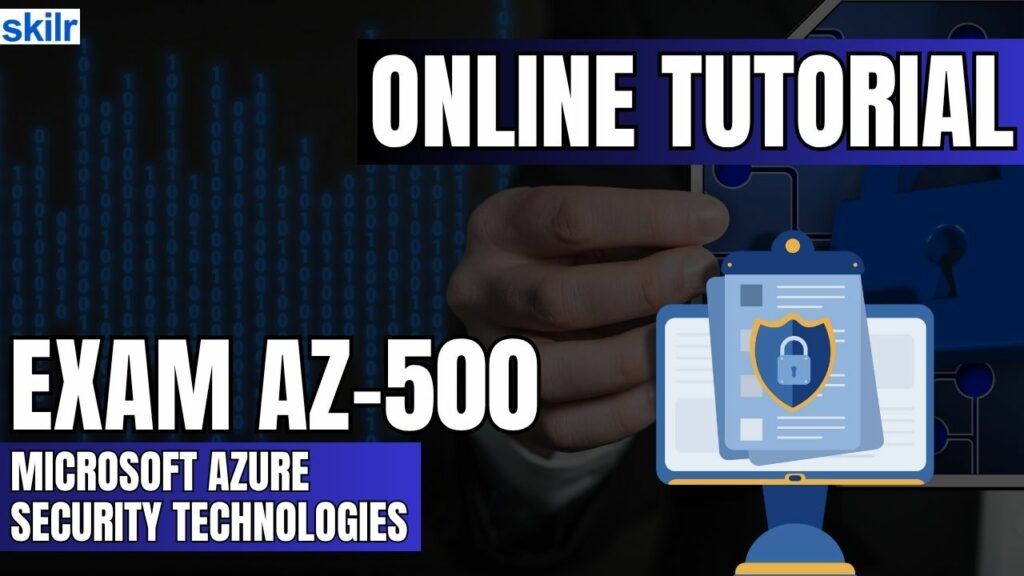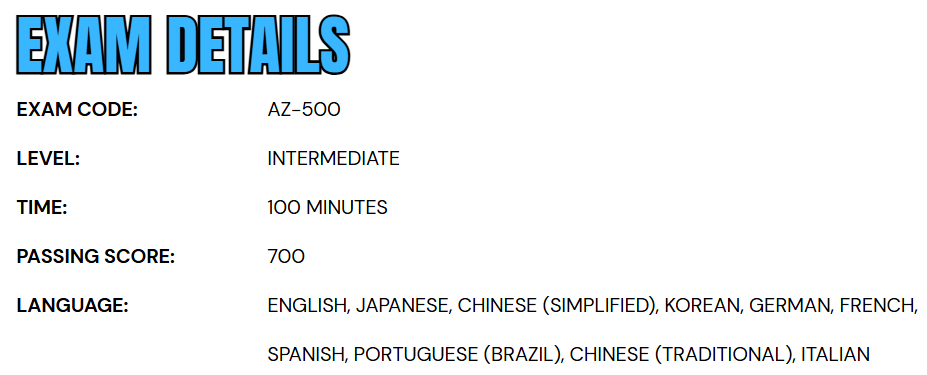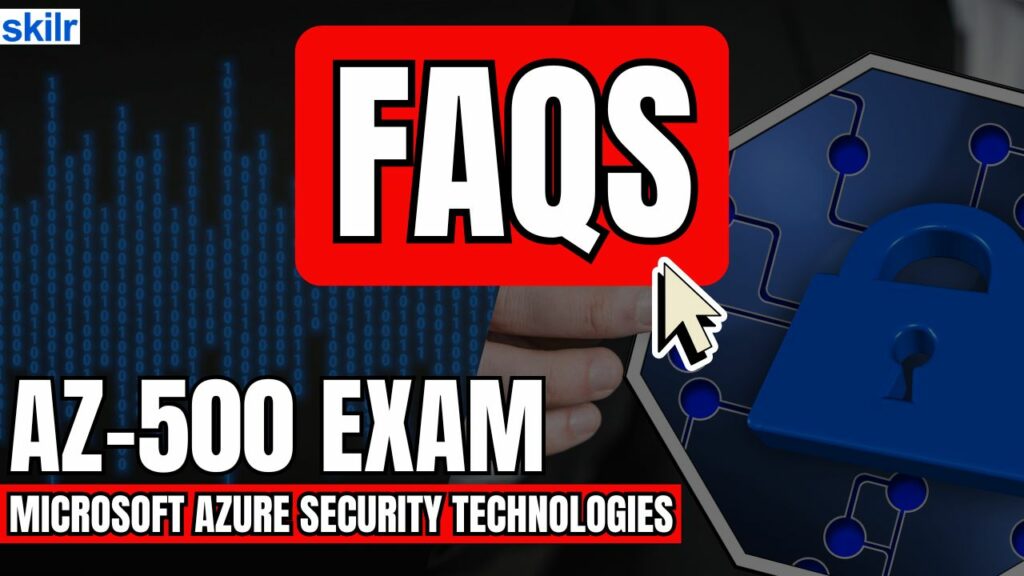
The AZ-500 certification is designed for professionals in the role of an Azure Security Engineer. These individuals are responsible for safeguarding Azure environments across cloud, multi-cloud, and hybrid infrastructures. The certification validates the ability to design, implement, and manage comprehensive security measures using tools such as Microsoft Defender for Cloud and other Microsoft-native security solutions.
Azure Security Engineers play a vital role in ensuring that systems are protected in alignment with frameworks like the Microsoft Cloud Security Benchmark (MCSB), adhering to best practices and regulatory standards.
– Key Responsibilities of an Azure Security Engineer
Professionals in this role are expected to perform a range of security-related tasks, including:
- Monitoring and managing security posture across the Azure environment.
- Deploying threat protection mechanisms to defend against evolving security threats.
- Detecting, assessing, and remediating vulnerabilities that could impact cloud workloads.
- Enforcing regulatory compliance controls throughout Azure-based infrastructures, which cover:
- Identity and access management
- Network security
- Compute and storage protection
- Data and application security
- Asset management and incident recovery
- DevOps security practices
– Collaboration and Integration
As a security engineer, collaboration is essential. You will work closely with cloud architects, system administrators, application developers, and security operations teams to implement solutions that meet organizational compliance and security goals. Participation in security incident response processes is also a key aspect of the role.
– Recommended Skills and Experience
To be well-prepared for this certification and career path, candidates should have:
- Hands-on experience managing Microsoft Azure and hybrid cloud environments.
- Strong understanding of Microsoft Entra ID (formerly Azure AD).
- Proficiency in core Azure services, including compute, networking, and storage technologies.
Exam Details

- The AZ-500: Microsoft Azure Security Technologies exam is designed for professionals at the intermediate level, specifically targeting the role of an Azure Security Engineer.
- This exam evaluates a candidate’s ability to implement, manage, and monitor security solutions in Microsoft Azure, including hybrid and multi-cloud environments.
- Candidates are allotted 100 minutes to complete the exam. It is a proctored assessment that may include interactive tasks simulating real-world security scenarios in Azure.
- The exam is available in the following languages:
- English, Japanese, Simplified Chinese, Traditional Chinese, Korean, German, French, Spanish, Brazilian Portuguese, and Italian.
- To successfully pass the exam, a minimum score of 700 is required.
- Microsoft provides exam accommodations for candidates who use assistive technologies, require additional time, or need modifications to ensure an equitable testing experience. Candidates can request these accommodations during the registration process for the exam.
Course Outline
The exam covers the following topics:
1. Securing identity and access (15–20%)
Managing security controls for identity and access
- Managing Azure built-in role assignments
- Managing custom roles, including Azure roles and Microsoft Entra roles
- Implementing and managing Microsoft Entra Permissions Management
- Planning and managing Azure resources in Microsoft Entra Privileged Identity Management, including settings and assignments
- Implementing multi-factor authentication (MFA) for access to Azure resources
- Implementing Conditional Access policies for cloud resources in Azure
Managing Microsoft Entra application access
- Manage access to enterprise applications in Microsoft Entra ID, including OAuth permission grants (Microsoft Documentation: Grant tenant-wide admin consent to an application)
- Managing Microsoft Entra app registrations
- Configuring app registration permission scopes (Microsoft Documentation: Introduction to permissions and consent)
- Managing app registration permission consent (Microsoft Documentation: Configure how users consent to applications)
- Managing and using service principals (Microsoft Documentation: Application and service principal objects in Azure Active Directory)
- Managing managed identities for Azure resources (Microsoft Documentation: What are managed identities for Azure resources?)
2. Securing networking (20–25%)
Planning and Implementing security for virtual networks
- Plan and implement Network Security Groups (NSGs) and Application Security Groups (ASGs) (Microsoft Documentation: Application security groups, Network security groups)
- Managing virtual networks by using Azure Virtual Network Manager
- Planning and implementing user-defined routes (UDRs)
- Planning and implementing Virtual Network peering or VPN gateway (Microsoft Documentation: Configure a VNet-to-VNet VPN gateway connection by using the Azure portal)
- Planning and implementing Virtual WAN, including a secured virtual hub (Microsoft Documentation: What is a secured virtual hub?)
- Secure VPN connectivity, including point-to-site and site-to-site (Microsoft Documentation: About Point-to-Site VPN, Create a site-to-site VPN connection)
- Implementing encryption over ExpressRoute (Microsoft Documentation: ExpressRoute encryption)
- Configuring firewall settings on PaaS resources (Microsoft Documentation: Configure Azure Storage firewalls and virtual networks)
- Monitoring network security by using Network Watcher, including NSG flow logging (Microsoft Documentation: Introduction to flow logs for network security groups, Log network traffic to and from a virtual machine using the Azure portal)
Planning and implementing security for private access to Azure resources
- Planning and implementing virtual network Service Endpoints (Microsoft Documentation: Virtual Network service endpoints)
- Planning and implementing Private Endpoints (Microsoft Documentation: What is a private endpoint?)
- Planning and implementing Private Link services (Microsoft Documentation: What is Azure Private Link?)
- Planning and implementing network integration for Azure App Service and Azure Functions
- Planning and implementing network security configurations for an App Service Environment (ASE) (Microsoft Documentation: Networking considerations for App Service Environment, App Service Environment networking)
- Planning and implementing network security configurations for an Azure SQL Managed Instance (Microsoft Documentation: Azure SQL Database and SQL Managed Instance security capabilities, Azure SQL Database security features)
Planning and implementing security for public access to Azure resources
- Planning and implementing Transport Layer Security (TLS) to applications, including Azure App Service and API Management (Microsoft Documentation: Add and manage TLS/SSL certificates in Azure App Service)
- Planning and implementing, and managing an Azure Firewall including Azure Firewall Manager and firewall policies (Microsoft Documentation: What is Azure Firewall Manager?)
- Planning and implementing an Azure Application Gateway (Microsoft Documentation: Application Gateway infrastructure configuration)
- Planning and implementing an Azure Front Door, including Content Delivery Network (CDN)
- Planning and implementing a Web Application Firewall (WAF) (Microsoft Documentation: What is Azure Web Application Firewall?)
- Recommending when to use Azure DDoS Protection Standard (Microsoft Documentation: Azure DDoS Protection)
3. Securing compute, storage, and databases (20–25%)
Planning and implementing advanced security for compute
- Planning and implementing remote access to public endpoints, including Azure Bastion and just-in-time (JIT (Microsoft Documentation: What is Azure Bastion?)
- Configuring network isolation for Azure Kubernetes Service (AKS) (Microsoft Documentation: Network concepts for applications in Azure Kubernetes Service (AKS))
- Securing and monitoring AKS (Microsoft Documentation: Monitoring Azure Kubernetes Service (AKS) with Azure Monitor)
- Configuring authentication for AKS (Microsoft Documentation: Access and identity options for Azure Kubernetes Service (AKS))
- Configuring security monitoring for Azure Container Instances (ACIs)
- Configuring security monitoring for Azure Container Apps (ACAs)
- Managing access to Azure Container Registry (ACR) (Microsoft Documentation: Azure Container Registry roles and permissions)
- Configuring disk encryption, including Azure Disk Encryption (ADE), encryption as host, and confidential disk encryption (Microsoft Documentation: Overview of managed disk encryption options, Azure Disk Encryption for Windows VMs)
- Recommending security configurations for Azure API Management (Microsoft Documentation: Azure security baseline for API Management)
Planning and implementing security for storage
- Configuring access control for storage accounts (Microsoft Documentation: Authorize access to data in Azure Storage)
- Managing life cycle for storage account access keys (Microsoft Documentation: Optimize costs by automatically managing the data lifecycle)
- Selecting and configuring an appropriate method for access to Azure Files (Microsoft Documentation: Mount SMB Azure file share on Windows)
- Selecting and configuring an appropriate method for access to Azure Blob Storage (Microsoft Documentation: Authorize access to blobs using Azure Active Directory, Choose how to authorize access to blob data in the Azure portal)
- Select and configure an appropriate method for access to Azure Tables (Microsoft Documentation: Authorize access to tables using Azure Active Directory)
- Select and configure appropriate methods for protecting against data security threats, including soft delete, backups, versioning, and immutable storage (Microsoft Documentation: Store business-critical blob data with immutable storage, Data protection overview)
- Configuring Bring your own key (BYOK) (Microsoft Documentation: Bring your own key (BYOK) details for Azure Information Protection)
- Enabling double encryption at the Azure Storage infrastructure level (Microsoft Documentation: Enable infrastructure encryption for double encryption of data)
Planning and implementing security for Azure SQL Database and Azure SQL Managed Instance
- Enabling Microsoft Entra database authentication
- Enabling database auditing (Microsoft Documentation: Auditing for Azure SQL Database and Azure Synapse Analytics)
- Planning and implementing dynamic masking (Microsoft Documentation: Dynamic Data Masking)
- Implementing Transparent Database Encryption (TDE) (Microsoft Documentation: Transparent data encryption (TDE))
- Recommending when to use Azure SQL Database Always Encrypted (Microsoft Documentation: Always Encrypted)
4. Securing Azure using Microsoft Defender for Cloud and Microsoft Sentinel (30–35%)
Implementing and managing enforcement of cloud governance policies
- Creating, assigning, and interpreting security policies and initiatives in Azure Policy (Microsoft Documentation: What is Azure Policy?)
- Configuring Azure Key Vault network settings (Microsoft Documentation: About Azure Key Vault)
- Configuring access to Key Vault, including vault access policies and Azure Role-Based Access Control (Microsoft Documentation: Provide access to Key Vault keys, certificates, and secrets)
- Managing certificates, secrets, and keys (Microsoft Documentation: Azure Key Vault keys, secrets and certificates overview)
- Configuring key rotation (Microsoft Documentation: Configure cryptographic key auto-rotation in Azure Key Vault)
- Performing backup and recovery of certificates, secrets, and keys
- Implement security controls to protect backups
- Implementing security controls for asset management
Managing security posture by using Microsoft Defender for Cloud
- Identifying and remediating security risks by using the Microsoft Defender for Cloud Secure Score and Inventory (Microsoft Documentation: Security posture for Microsoft Defender for Cloud)
- Assessing compliance against security frameworks and Microsoft Defender for Cloud (Microsoft Documentation: Improve your regulatory compliance)
- Managing compliance standards in Microsoft Defender for Cloud
- Adding custom standards to Microsoft Defender for Cloud
- Connecting hybrid cloud and multi-cloud environments to Microsoft Defender for Cloud, including Amazon Web Services (AWS) and Google Cloud Platform (GCP) (Microsoft Documentation: What is Microsoft Defender for Cloud?)
- Implementing and using Microsoft Defender External Attack Surface Management (EASM)
Configuring and managing threat protection by using Microsoft Defender for Cloud
- Enabling workload protection services in Microsoft Defender for Cloud
- Configuring Microsoft Defender for Servers, Microsoft Defender for Databases, and Microsoft Defender for Storage (Microsoft Documentation: Onboard Windows servers to the Microsoft Defender for Endpoint service)
- Implement and manage agentless scanning for virtual machines in Microsoft Defender for Servers
- Implementing and managing Microsoft Defender Vulnerability Management for Azure virtual machines
- Connecting to and configuring settings in Microsoft Defender for Cloud Devops Security, including GitHub, Azure DevOps, and GitLab
Configuring and managing security monitoring and automation solutions
- Managing and responding to security alerts in Microsoft Defender for Cloud
- Configuring workflow automation by using Microsoft Defender for Cloud
- Monitoring network security events and performance data by configuring data collection rules (DCRs) in Azure Monitor
- Configuring data connectors in Microsoft Sentinel
- Enabling analytics rules in Microsoft Sentinel
- Configuring automation in Microsoft Sentinel
Microsoft AZ-500 Exam FAQs
Microsoft Certification Exam Policies
Microsoft maintains a consistent and transparent framework of certification exam policies to ensure fairness, integrity, and uniformity throughout the certification process. These policies are strictly enforced across all testing modalities, whether candidates are taking their exams remotely under supervision or at an authorized testing center.
– Exam Retake Policy
Candidates who do not pass an exam on their initial attempt must observe a minimum 24-hour waiting period before retaking the test. For each subsequent attempt, a 14-day waiting period is required. Microsoft allows up to five exam attempts within 12 months for the same certification. Once the exam is passed, additional retakes are not permitted unless a recertification is required due to exam expiration. Please note that standard exam fees apply to every attempt, including retakes.
– Rescheduling and Cancellation Policy
Candidates may reschedule or cancel their exam appointments at no cost if the request is submitted at least six business days before the scheduled exam date. Changes made within five business days of the exam may be subject to rescheduling or cancellation fees. If a candidate cancels within 24 hours of the exam time or fails to appear, the full exam fee will be forfeited.
Microsoft AZ-500 Exam Study Guide

Step 1: Understand the Exam Objectives Thoroughly
Begin your preparation by gaining a clear understanding of the exam objectives outlined by Microsoft. These objectives serve as the blueprint for the exam and define the specific knowledge areas and skills that will be assessed. Key focus areas include identity and access management, platform protection, security operations, and data and application security. Review the official exam skills outline provided on Microsoft Learn to identify any knowledge gaps and structure your study plan accordingly.
Step 2: Leverage Official Microsoft Training Resources
Make use of Microsoft Learn, the official platform for free, self-paced learning modules and interactive labs. These resources are specifically designed to align with the AZ-500 exam objectives and are regularly updated to reflect changes in Azure services and best practices. You can also explore instructor-led training through Microsoft Learning Partners, which provide deeper insights and expert guidance. Prioritizing official resources ensures your preparation is accurate, current, and aligned with real-world scenarios. The modules are:
- Securing identity and access
- Learn about securing networking
- Securing compute, storage, and databases
- Understand about securing Azure using Microsoft Defender for Cloud and Microsoft Sentinel
Step 3: Join Study Groups and Professional Communities
Participating in online study groups and professional forums can significantly enhance your learning experience. Platforms such as the Microsoft Tech Community, LinkedIn groups, Reddit, and certification-focused Discord servers allow you to connect with other candidates and experienced Azure professionals. Engaging in these communities can provide valuable tips, answer specific doubts, and offer motivation through shared learning goals and progress.
Step 4: Practice with AZ-500 Exam Simulations and Sample Questions
Regular practice using AZ-500 exam simulations and sample questions is crucial for building confidence and reinforcing your understanding. Look for reputable practice tests that simulate the actual exam format, time constraints, and question styles. Analyze your results to identify weak areas and focus your revision on those topics. Consistent practice helps improve retention, time management, and reduces exam-day anxiety.
Step 5: Apply Your Knowledge in Hands-On Labs
Security engineering is a practical field, and hands-on experience is vital. Set up a personal Azure test environment or use sandbox labs provided by Microsoft Learn to apply theoretical knowledge in real-world scenarios. Practice tasks such as configuring Azure Firewall, setting up Microsoft Defender for Cloud, managing access policies, and responding to simulated threats. Practical exposure reinforces concepts and enhances your ability to troubleshoot and implement solutions effectively.
Step 6: Review, Revise, and Plan Your Exam Day
In the final phase of your preparation, allocate time for a comprehensive review and revision. Go over your notes, revisit challenging topics, and take a few more practice exams to gauge your readiness. Ensure you are familiar with the exam structure, policies, and technical requirements for remote or in-person testing. On the exam day, stay calm, manage your time wisely, and approach each question methodically.


